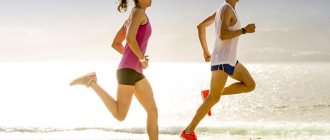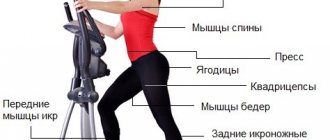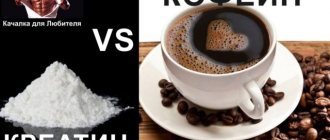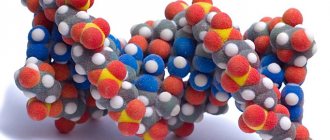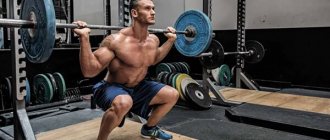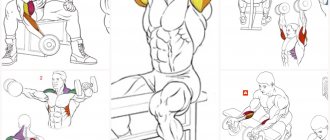Advantages and disadvantages of morning classes
To begin with, let us draw your attention to the fact that after waking up, the human body remains at rest for another three hours. Exercising in the morning helps all muscle groups fully awaken.
The advantages of this time for activity include:
- Exercise is an impetus for increasing blood circulation, which, in turn, will be an excellent incentive for work.
- Exercising at this time promotes muscle growth.
- In the morning, excess fat is burned more actively, since the body has not yet received a dose of food and energy is taken from stored reserves.
- Physical activity on an empty stomach does not slow down metabolism; its speed still remains at the same level for a certain time after the completion of the activity process. It turns out that excess deposits continue to burn even after training.
There are also disadvantages:
May have negative effects on the heart and blood vessels. During sleep, the body is at rest; activity increases blood pressure and, accordingly, the heart rate. A weakened heart will not be able to cope with pumping blood;
- Exercising before meals can negatively affect the functioning of some internal organs.
- After any type of exercise, our body needs nutrients. There comes a feeling of extreme hunger, which can subsequently lead to overeating.
Insulin
Insulin is a hormone that regulates the use of nutrients by the liver, body muscles and fat cells. Insulin is produced in response to carbohydrates entering the body. Every time you eat a banana, chew a carrot, swallow a sandwich or drink juice, your body produces insulin, which controls the absorption of nutrients.
Insulin thus helps control fat cells and food absorption. And lack of sleep, lack of mobility (or a sedentary lifestyle without exercise), and overheating of the body make our bodies less sensitive to the effects of insulin. This so-called insulin resistance makes us more prone to diabetes, certain types of cancer and obesity, which is a major health problem in developed countries.
If you decide to exercise when most of the glucose and glycogen from your last meal has been used up, your body is likely to turn its attention to fat cells as an energy source. After fasting, your body becomes most sensitive to the insulin it produces whenever you eat. This sensitivity does magical things - it uses carbohydrates, proteins and fats more efficiently, promoting body muscle growth and fat burning.
One of the explanations why the topic of insulin resistance has become such a hot topic today is the theory of “thrifty” genes. She states that our metabolism speeds up when we consciously vary periods of eating and fasting, vigorous exercise and rest. This is in stark contrast to the lifestyle of the modern average person with his sedentary lifestyle, abundance of food and constant consumption of it.
Contraindications
If you do not have certain physical abnormalities and you feel excellent, then you can safely start morning sports activities. There is no need to be afraid of consequences in the form of health problems in your case.
If you have problems, you need to consult a doctor. He will be able to tell you which exercises you can do and which ones you should avoid.
Basically, there are no strict contraindications to morning exercises. Almost every person is able to perform simple exercises.
There are the following restrictions:
- A cold that is accompanied by high body temperature.
- Presence of bleeding.
- Inflammation.
- Problems with normalizing blood pressure.
- Presence of malignant tumors.
- Kidney diseases.
Protein
After these facts, you may be thinking, “even if exercising on an empty stomach is beneficial in the short term, does fasting affect protein digestion and muscle mass?” In fact, studies in young, middle-aged, and elderly adults have found that you can take your daily dose of protein at one time without harmful effects.
In general, if you are not an athlete, then your strategy can be quite simple. If you don't want to eat, then don't eat.
Speaking about training on an empty stomach, we can say the following: skipping one or two meals before training will not harm your body. Intermittent fasting can reverse the effects of a sedentary, high-fat, high-calorie diet and make more efficient use of the food you eat. Working out in the morning on an empty stomach will help you better absorb the foods you eat after your workout.
Nutrition before and after training
Some people prefer to train on an empty stomach, while some people like to eat a light meal before training. It all depends on the capabilities of each person. Those who prefer to exercise first, and then eat, must observe a time interval of about 20-30 minutes between processes.
If you feel dizzy and have no strength for physical activity, then in this situation it is better to eat a light breakfast half an hour before training.
Below we will discuss in more detail what you can eat depending on the time indicator.
What you can and cannot eat
Let's figure out what you can eat before physical activity.
Your diet should consist of protein foods and carbohydrates. Fats are not recommended for consumption. Fatty foods take a long time to digest in the stomach, which can cause pain, nausea, etc. Carbohydrates supply our body with a boost of energy, which will be consumed during exercise. Protein foods are the main sources of substances such as amino acids necessary for muscle function.
After physical activity, eating should not be delayed for long. The effectiveness of the exercises will be reduced. All the substances that the body receives during this intake will be used to restore the condition of the muscles and increase their mass. There will be no deposits in the form of fat.
What can you eat?
Carbohydrates can be taken in liquid form, such as grape juice. It is very important to eat protein foods after physical activity. The correct dosage is calculated based on the size of your palm - the food should fit in it, no more. Since the purpose of morning exercise is weight loss and muscle gain, you should not eat fatty foods. For example, if you plan to eat chicken, give preference to fillet. You can eat egg whites, not very fatty cottage cheese.
If you are faced with a choice of red meat, then dietary veal is an excellent option. You should eat fatty fish more often; it can be baked in the oven or steamed.
Coffee lovers are better off taking a two-hour break after exercise. This is what a sample menu looks like.
Sports nutrition and supplements
Sports nutrition helps the body receive all the necessary active supplements, taking into account daily training. It cannot replace a healthy diet, but is only a complement to it.
There are the following main types:
- Protein. These are protein-rich foods. They contain a minimal amount of carbohydrates. This diet is intended for both weight loss and muscle gain. This is a great option for snacking between meals.
- Gainer. This is a mixture consisting of proteins and carbohydrates. Helps build muscle and restore energy after a workout.
- Fat burners. They will only help in combination with physical activity. Accelerate metabolism;
- Amino acids. Such sports nutrition will help restore muscle condition and reduce soreness.
- Energy. Gives energy during strength training, adds endurance;
- Vitamins. Helps increase stamina and strengthen the immune system. Accepted as a course.
- Carbohydrates. After training, you can include fast carbohydrates that have a high glycemic index in your diet. Energy drinks and gels are suitable, and you can also purchase special bars.
Features of strength training on an empty stomach
Strength training on an empty stomach has its benefits.
Such activities trigger metabolism and maintain it at maximum level for a long time. A few hours after training, you will actively lose calories and burn subcutaneous fat. This will allow you to lose weight and get in shape much faster. Physical activity on an empty stomach increases energy potential, gives a charge of vigor and good mood for the whole day. They stimulate the release of endorphins, which improves the athlete's performance and training performance. Additionally, the level of somatropin and testosterone increases.
Regular exercise on an empty stomach increases willpower, helps develop discipline, dedication and concentration. They have a beneficial effect not only on physical health and body formation, but also help stabilize the psycho-emotional state.
If you decide to try your hand at fasted training, follow the basic rules:
- On the day of class, get up half an hour to an hour earlier to prepare yourself mentally and psychologically for the upcoming loads.
- To satisfy your hunger, drink plain water or mineral water without gases. The liquid will help the body wake up faster, start metabolism and dull the appetite.
- The duration of the training should be 40-60 minutes. With less time spent, you will not achieve the desired result, and in the case of a longer session, there is a high risk of developing a catabolic reaction and severe fatigue.
- During training, use as many muscles as possible. To perform exercises, use available exercise equipment and sports equipment with a feasible weight. However, avoid extreme fatigue, overtraining and complete depletion of energy reserves.
- Watch your breathing while doing the exercise: inhale while relaxing and exhale when tense. Improper or delayed breathing can lead to fainting, dizziness, low blood pressure, or loss of energy.
- At the end of the training, give your body some rest and recovery. This will avoid overtraining, fatigue, decreased motivation and stress.
- Start eating at least an hour after training. Delayed eating will allow you to burn more fat due to active post-workout metabolism. Breakfast should be enriched with protein and carbohydrates.
- To achieve maximum results, add cardio exercises to your strength training or alternate between aerobic and anaerobic exercise on an empty stomach every other day.
Strength training on an empty stomach does not promote muscle growth, but it does help you lose weight and, if necessary, “get lean.” This type of activity has a number of contraindications and side effects, so weigh the pros and cons before starting this type of activity.
Correct technique and types of exercises
Professional athletes always monitor the technique of performing exercises and complexes. Failure to follow the rules is unlikely to lead to benefit, but on the contrary, it can cause harm.
By adhering to the required execution scheme, you will get:
- Load efficiency.
- Protection from damage.
- More endurance.
For beginners, to learn the correct technique, you can seek help from a fitness trainer or watch videos that are freely available on the Internet.
Example workout
Let's take a closer look at the main types of exercises for morning exercises, depending on where they are held.
At home
The program may include:
- Cardio training. This includes running, jumping rope, and energetic types of dance elements. A 15 minute run will be enough.
- Exercises for the upper region (arms, chest and back). Push-ups from a wall or floor, lifting your arms with weights at different body positions.
- Exercises for the abs. This could include crunches, a “climber” exercise, leg lifts from a lying position, or a static plank.
- Complex for the lower body (legs and buttocks). Popular types are squats, bent and straight leg abductions.
An example of a morning program at home:
- 1 exercise - jump rope: 3 sets of 1 minute (break no more than 20 seconds).
- Exercise 2 - push-ups: 3 sets of 10-15 times (break 20-30 seconds).
- Exercise 3 - static plank: 3 sets of 1 minute (rest 30 seconds between sets).
- Exercise 4 - squats without weight: 3 sets of 20 times (break 20 seconds).
- 5 final exercise - 1 minute of jumping rope.
In the gym
While in the hall, you can use all the equipment provided. For example, weights and dumbbells, balls, hula hoops, treadmills, orbitracks, etc.
The following exercises are suitable for men:
- Lunges with weights.
- Elbow plank.
- Side plank.
- Push-ups.
- Dumbbell press in any body position.
For women and girls you can use the following complex:
- In order to remove fat on the stomach and sides, you can use cardio equipment. Every gym has treadmills and cycling tracks.
- Prone or side plank.
- Push-ups, emphasis on hands.
- Lunges with dumbbells.
- Jumping.
Training Tips
In order to achieve the desired result, you must follow a number of rules. We have collected some useful tips for you.
Warm-up and stretching
Be sure to do a warm-up before training. This includes jumping and running. This helps warm up the muscles and increase blood circulation in the vessels. It is thanks to the warm-up that your muscles will be ready for physical activity, and the ligaments will not be damaged.
After finishing, it is also worth doing some stretching, this helps to quickly restore the muscle structure.
Sets and reps
Initially, 1-2 approaches will be enough. The exercise must be repeated 10-15 times in one approach. Then you can increase the number of approaches and repetitions depending on your capabilities.
Equipment
All exercises should be done only in special sportswear and shoes. This also applies to home workouts. Such equipment allows you to quickly remove sweat and provide access to air. Sneakers will help protect your feet and knees from damage.
Duration of training
For beginners, the first classes should start with 20-30 minutes, then you can gradually increase them. You can eventually work your way up to 60-90 minutes of vigorous exercise.
How many times a week
To begin with, you need to start with 2-3 times a week. Once your body is stronger and your endurance is higher, you can begin daily exercise.
Why is fat deposited in our body?
After you've had lunch and gone about your business, a complex chemical process begins in your body. The body, which has received energy from the outside with food, begins to convert it into the energy necessary to maintain its vital functions.
Part of the energy is glycogen - will be sent to the muscles and liver. Glycogen stored in the liver provides the body with glucose. And glycogen, which is stored in muscles, is needed for physical activity. Since glycogen can accumulate in the liver and muscles in rather limited quantities, its excess is transformed into fat and sent to the so-called fat depot. This will already be a strategic reserve, which is not so easy to obtain: the body resorts to it only when the glycogen reserve is depleted.
If you haven’t moved much during the day and haven’t used up your glycogen reserves, your body will convert it into fatty tissue and store it until better times.
Be sure to read: A set of effective exercises for losing weight on your butt
Nowadays, when supermarket shelves are replete with food products whose energy value is tens of times higher than the natural needs of the body, gaining excess weight is not difficult. High-carbohydrate foods such as buns, chocolate, pies, sweets, cakes in just one serving can contain the body's daily need for carbohydrates. And all this goes straight to the fat depot: this is the peculiarity of “fast” carbohydrates. But once you make adjustments to your diet, replacing “fast” carbohydrates with “slow” ones (porridge, pasta made from durum wheat, bread made from whole grain flour), the body will begin to rationally distribute the calories received. Of course, you can gain weight with proper nutrition. But here the amount of food eaten will matter.
So, we learned that the body uses glycogen throughout the day. By leading a sedentary or office lifestyle, you are unlikely to ensure that it reaches fat reserves and begins to use them up.
In order to start burning fat, we need to engage in aerobic training. Aerobic or cardio training is a type of physical activity in which oxygen plays a major role. It is oxygen that will start the process of breaking down fat into energy and water, and this is exactly what we strive for!
Jogging in the fresh air, cycling uphill, water aerobics, play sports, dancing - all of this refers to aerobic exercise that is best suited for those who want to lose weight and get rid of subcutaneous fat deposits.
Cardio on an empty stomach in the morning, before breakfast, significantly increases the effectiveness of weight loss. The fact is that while you were resting at night, glycogen reserves were used up to maintain the basic needs of the body. This is why, as a rule, we feel hungry in the morning: we need to replenish quick energy and begin our daily activities.
If you go for a morning run or do a 40-minute fitness workout instead of breakfast, your body will be forced to use fat as energy.
Common mistakes
The most common mistake is poor nutrition. This should not be done; you need to eat right and drink properly, adhering to the calculated dose for weight loss.
Stopping training after not getting immediate results. The scales will not show you minus right away; here you need to show perseverance and determination. It is better to take photographs over a period, for example, once a week. You can see positive changes from them.
Most people focus on one type of exercise. This is not correct; it is necessary to work out each muscle group.
A growth hormone
In fact, opinions about this hormone are mixed. It is present in the bodies of children and adolescents and is declared as an anti-aging factor for older people. But while its effectiveness against aging has not been confirmed, it directly affects the growth of muscle mass and increased muscle strength. Daily fasting can increase the production of growth hormone in the body by 1.5 times.
Testosterone is one of the hormones that directly affects the increase in muscle mass and burning fat in the body. And it is precisely because of this that the answer to the question of whether it is possible to do strength exercises on an empty stomach can only be in the affirmative. With a short-term refusal of food, the effectiveness of strength exercises increases several times.
Reviews from those who have lost weight
We have collected for you several reviews of people who lost weight thanks to morning workouts, maintaining punctuation and spelling:
“I’ve been working out at home in the morning for more than 5 months. It’s more convenient for me because I’m on maternity leave and at this time my baby is still sleeping. I started working out without weights, then I connected them. I and those around me began to notice changes within a few weeks. I’m not going to stop there,” young mother Elena shared with us.
“I train in the morning, before work. I start running at 5:30 am. It’s more convenient for me, and I got my figure in shape, and a charge of good mood for the whole day,” writes Zhanna.
“Now I train in the evening. When the goal was to lose weight, I strictly followed the schedule - jogging in the morning, then a shower and a light breakfast. At the moment, it’s hard for me to train in the gym in the morning, although I know that it’s better to do cardio then,” the user chose to remain anonymous.
Conclusion
To summarize, I would like to point out that to achieve your goal, it is not enough to limit yourself in food. It is also necessary to exercise. The time when you do this completely depends on your capabilities and desires.
We hope that all the information in the article was useful to you. you have defined goals for yourself and received answers to all your questions. If this is the case, then do not forget to share this article with your friends and subscribe, because there will be a lot more interesting and valuable things to come.
See you soon!

